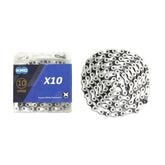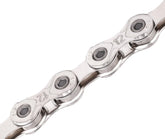The bicycle chain is one of the most essential components in the drivetrain system, responsible for transferring power from the pedals to the wheels. Whether your bike is geared or non-geared (single-speed), the chain plays a crucial role in ensuring a smooth and efficient ride. Over time, chains can stretch, wear out, or become damaged, requiring timely maintenance or replacement to maintain optimal performance.
Let’s explore bicycle chains, their components, and their respective spare parts, with a focus on geared and non-geared bikes.
Bicycle Chain Overview
A bicycle chain consists of a series of links, each formed by plates and rollers, which connect to the chainrings (front gears) and the rear cassette (or freewheel) to transmit pedaling power. Chains are made from steel but can also be found in lighter materials like chromoly steel, aluminum, or stainless steel for certain types of bicycles.
Types of Bicycle Chains
1. Geared Bicycle Chains
Geared bike chains are designed to work with a multi-gear system, where the chain moves between the different cogs on the cassette and engages with the front chainrings. These chains are often narrower than non-geared chains to fit the tighter spacing of cogs.
Features:
-
Narrower links to fit between closely spaced gears.
-
Durability to handle shifting under tension.
-
Specific speed rating: 7-speed, 8-speed, 9-speed, 10-speed, 11-speed, and even 12-speed chains are available, each having a different width to fit the appropriate gear system.
Common Applications:
-
Mountain bikes (MTB)
- Road bikes
- Commuter bikes
2. Non-Geared Bicycle Chains (Single-Speed Chains)
Non-geared (single-speed) chains are wider than geared chains and are built to handle the simpler drivetrain found in single-speed bikes, where the chain only moves between the front chainring and the rear cog.
Features:
-
Wider links compared to geared chains.
-
Fewer parts: No need to deal with multiple gears and narrower spacing.
-
Durability for basic, low-maintenance rides.
Common Applications:
-
Fixed-gear bikes (fixies)
- Single-speed bikes
- Cruisers
-
Commuter bikes (for simplicity)
Components of a Bicycle Chain
-
Chain Links:
-
Description: A bicycle chain is made up of a series of interlinked components, called chain links. Each link is composed of two outer plates and one or more inner plates, with a roller and pin connecting the plates.
-
When to Replace: Links can become worn over time, causing the chain to stretch. If the chain stretches beyond a certain point, it may not shift properly or may wear out the gears faster.
-
Rollers:
-
Description: The rollers are circular components that reduce friction between the chain and the cog. These rollers rotate as the chain moves through the drivetrain.
-
When to Replace: If the rollers become worn out, the chain can skip or become inefficient, and they should be replaced to maintain smooth movement.
-
Outer Plates and Inner Plates:
-
Description: These are the metal plates that make up the links of the chain. The inner plates are designed to fit around the rollers, while the outer plates help connect the links together.
-
When to Replace: If plates become cracked, bent, or broken, the chain will lose its integrity, and the whole chain may need replacement.
-
Chain Pins:
-
Description: Pins hold the individual links of the chain together and allow it to flex as it moves around the chainring and cassette.
-
When to Replace: Pins can break or become loose, leading to a damaged or malfunctioning chain. A broken pin should be replaced, or the chain may need to be replaced entirely.
-
Master Link (for Geared Chains):
-
Description: A special link used for easy chain installation and removal, often found in geared bike chains. It allows the chain to be broken down without tools.
-
When to Replace: If the master link becomes damaged or hard to use, it should be replaced.
Bicycle Chain Spare Parts
There are several spare parts associated with bicycle chains, which can be replaced to ensure the smooth functioning of the drivetrain:
1. Chain Link Connector/Quick Link (Master Link):
-
Description: A connector link that allows for quick chain removal and reassembly. Found primarily in geared bicycle chains.
-
When to Replace: If the quick link becomes damaged or too stiff to engage, it should be replaced to maintain the chain’s flexibility.
2. Chain Pins:
-
Description: Pins hold the chain links together. They can be a single-use part in some chains, while others may have removable pins.
-
When to Replace: A chain pin may become worn, or the link it connects to may fail, requiring replacement of the pin or the entire chain link.
3. Chainring:
-
Description: The chainring is the large gear attached to the pedal crankset that the chain engages with. Geared bikes typically have multiple chainrings, while single-speed bikes typically have one.
-
When to Replace: Over time, the teeth on the chainring can wear down, leading to poor chain engagement. If the teeth become worn or broken, it’s time to replace the chainring.
4. Cassette or Freewheel (for Geared Bikes):
-
Description: The cassette or freewheel is the cluster of gears on the rear wheel that the chain engages with. It is a critical component of a geared bicycle drivetrain.
-
When to Replace: If the cassette teeth are worn or the gear shifting is difficult, it’s time to replace the cassette.
5. Chain Tensioner (for Single-Speed Bikes):
-
Description: This component helps keep the chain taut on single-speed bikes by adjusting the position of the rear wheel.
-
When to Replace: If the chain tensioner becomes damaged, misaligned, or bent, it may need replacement.
Chain Maintenance and Care Tips
-
Regular Cleaning:
- Keeping the chain clean is essential for its longevity and performance. Use a degreaser and chain cleaning tool to remove dirt, dust, and oil buildup.
-
Lubrication:
- Lubricate the chain regularly with bike-specific chain lube. Apply the lube to the inside of the chain and wipe off any excess to prevent attracting dirt.
-
Check for Chain Wear:
- Use a chain checker tool to measure chain wear. If the chain elongates beyond a certain point (usually 0.5% to 1.0% wear for most chains), it's time for a replacement to prevent unnecessary wear on the cassette and chainring.
-
Chain Stretch:
- Over time, chains stretch due to use. A stretched chain will no longer fit properly into the cogs and chainrings, resulting in poor shifting performance. It’s important to replace the chain before it causes damage to the other drivetrain components.
-
Avoid Over-Shift:
- Over-shifting (e.g., shifting while pedaling under high force) can put unnecessary stress on the chain, leading to premature wear. Shift gears carefully to avoid excessive tension on the chain.
-
Proper Chain Installation:
- When installing a new chain, make sure it's the correct length and installed in the proper direction. An incorrectly sized or installed chain will wear out more quickly.
Conclusion
The bicycle chain is a critical component of your bike, whether you have a geared or non-geared system. Regular maintenance, including cleaning, lubrication, and checking for wear, will keep your chain performing smoothly. For geared bikes, pay attention to the cassette, chainring, and quick link. For single-speed bikes, focus on maintaining the chain tensioner and ensuring proper chain length.
Replacing chain links, chainrings, or cassettes as needed will prevent further damage and improve your bike’s efficiency. Whether you're a commuter, casual rider, or enthusiast, taking care of your chain will ensure a smooth, safe, and enjoyable ride.








